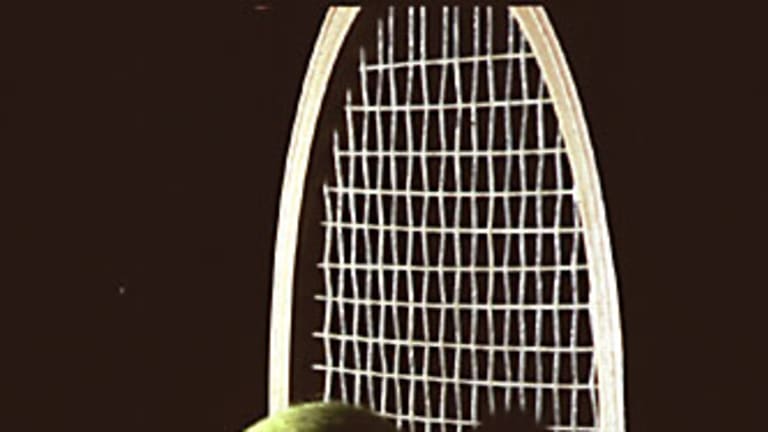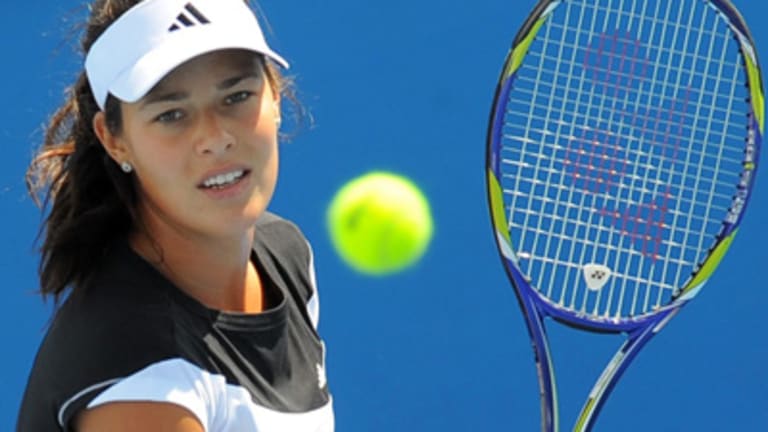There’s a mystery, a void in our understanding of the rules of cause and effect, at the center of professional tennis at the moment. It has to do with Ana Ivanovic’s serve. The unanswerable question is this: Why can’t the former French Open champion toss the ball in the right place? Her wayward throws have been with her at least since the 2007 Roland Garros final, when she opened her match—an eventual straight-set loss—against Justine Henin by sending a couple of them darting out to her right, and sending frightening visions of Jana Novotna through the minds of fans around the world. Fortunately, those fears were unfounded. Ivanovic got her yips under control in Paris and seemed to banish them for good in 2008.
In 2009 they returned with a vengeance. Ivanovic’s serve, once a weapon, was now cringe-worthy, a train wreck. No amount of work or thought or mid-match adjustment could help her put the ball where she wanted it go for more than a few games at a time. In her early-round, side-court matches at Wimbleon, the buzz of excitement would turn to a buzz of fear after her first toss, which inevitably slipped out of her hand and flew wildly. As her part-time coach, Darren Cahill, said last summer, when your serve goes south, the rest of your game will follow. By the time she got to the Australian Open this year, Ivanovic’s game and confidence were closer to the vicinity of Antarctica. I thought a friendly exhibition at Madison Square Garden on Monday might ease her serving burdens, but while she played some solid tennis, the errant toss was still in evidence. Yesterday, Pete Bodo quoted her new coach, Heinz Gunthardt, as saying that Ana would need to learn to think a little less about her serve to get it under control. That’s undoubtedly true—there's nothing worse than an athlete thinking about what she’s doing as she's doing it. And Ivanovic’s serving problems, while they may stem from a technical glitch in the way she raises her left arm—she almost seems to relax it to the point where she no longer has any control over it—it’s a psychological issue at bottom, a manifestation of anxiety that becomes self-fulfilling. It’s a hitch.
Is it possible for an athlete to unthink his or her way out of a hitch? The most famous example in American sports is Steve Sax, a second baseman who woke up one day and couldn't throw the ball to first base. He was so wild that fans in the seats behind first base started wearing helmets for mock-protection when he played. It took Sax six years, but he did manage to get his “disease” under control (It really is known as “Steve Sax disease,” and it has affected a few other second baseman; the problem is that, unlike a throw from a shortstop, the second baseman doesn’t need to throw his hardest to get the ball there in time, which means he ends up aiming it, which in turn means he ends up thinking about it.) In tennis, Elena Dementieva has had the most famous recent case of the yips. By experimenting with various tosses, she has also brought them under a certain degree of control.
Still, Dementieva’s nerves remain part of her body and her personality, and they continue to act up at inopportune moments. I don’t know if anyone has devised a successful method for practicing not being nervous, or pretending that an important point doesn’t matter; it’s like practicing being confident. In tennis, confidence can only come from having something go right for you during a match. It doesn’t even have to be something you’ve done yourself. If your opponent donates a win to you by making 100 unforced errors, the simple fact that you’ve won, no matter what the quality of your play may have been, is what will make you feel like you can win again. Confidence, and the lack thereof, is a volatile mix of cold, hard, reality-based analysis, total irrationality, and wishful thinking.
From a personal perspective, I’m guessing it will be a long, bumpy, tricky road to getting Ana to unthink her way to a better serve. Maybe that’s because as a player, I’ve felt her anxious pain for years. It’s not on my serve. I was taught to reach up for my imperfect tosses and hit them whenever I could, because no one, not even a pro, places the ball in the exact same spot every time. There’s some variation in every player’s toss, so you might as well make your motion as flexible as possible to accommodate that variation (this would obviously not work for Ivanovic, who would fall flat on her face if she attempted to hit her worst tosses). No, the train wreck for me wasn’t my serve; it was, and still is, my backhand. Be warned: It’s a sad story, of a disease for which there would never be a cure.
When I first played tennis, at age 8, the only shot I could hit over the net was my two-handed backhand. The stroke was unorthodox, born out of my baseball swing. I’m left-handed, but I bat right-handed, and I transferred a baseball grip and swinging motion from the Little League diamond to the tennis court (if it looked like anyone’s, it looked something like Jim Courier’s two-hander). For the first six or seven years I played, my backhand was my best stroke, my only weapon. I can remember playing matches in the 12s and 14s when I found myself hitting winners with it that I was only half-trying to hit. Sometimes it felt so grooved that I couldn’t have missed it if I’d tried. I can still remember the feeling I had when, during a practice set with an older kid at the cracked courts at our local elementary school, I sent two straight backhands crosscourt for blatant winners. After the second one, my opponent stopped and stared at me, as if to say, “Where the hell did that come from?” It was the first time I felt like I could be a good tennis player someday.

